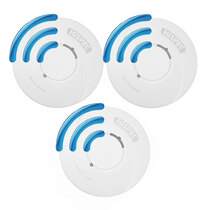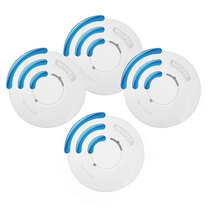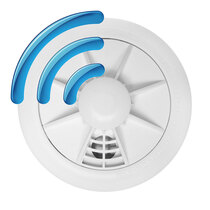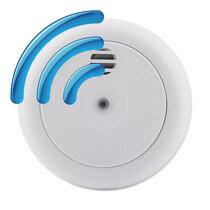-
Contact
Sales & Customer Service
0800 612 6537 support@safelincs.co.uk Live ChatDelivery Enquiries
0800 077 6149 - Resources
Fire & Safety Solutions
CALL OUR TEAM NOW 0800 612 6537
Lines open today 8am - 6pm
FREE Delivery
on marked products
Live Chat - Online
Instant help & Advice
Trade Discounts
and exclusive pricing
0% Credit Available
Open an account now
5 Star Customer Feedback
Battery Smoke Alarms
A battery smoke alarm is the simplest level of fire detection. At a very basic level, there are standalone units with no interlink capabilities, whereas with more advanced models including a tamper-proof battery and radio interlink technology provide a little more coverage and warning to the event of a fire in your property.
These alarms are available as optical smoke detectors (detects slow smouldering fires), suitable for hallways, bedrooms, and living rooms, or as heat alarms (detects rapid increases in temperature), designed for kitchens and garages, or where lots of dust, fumes, steam, or other contaminants may cause false alarms.
Some battery-only powered alarms have a battery compartment to replace the depleted batteries every 12 to 18 months, throughout the alarms 10-year lifespan. Others have a sealed battery, which lasts the lifespan of the alarm.
All of our battery smoke detectors and heat alarms are suitable for Grade F installations, and meet the requirements for Grade F1 or F2. Please see our guide to BS 5839-6: 2019 for more information on Grades of alarms.
Radio-Interlinked Battery Powered Optical Smoke Alarm - UltraFire UBS1RF
- Battery: AA alkaline batteries (included)
- Warranty: 10 year warranty
- Large test and hush button
- Toast-proof sensor
- Wireless interlink up to 50 compatible alarms
- No central control panel needed
- Suitable for BS 5839-6: 2019 Grade F2 installations
- Certified to BS EN 14604: 2005
4.8 out of 5 stars
View Product
| 1 unit |
£22.79 inc VAT £18.99 ex VAT |
|---|---|
| 2+ units |
£21.59 inc VAT £17.99 ex VAT |
Radio-Interlinked Battery Powered Heat Alarm - UltraFire UBH1RF
- Battery: AA alkaline batteries (included)
- Warranty: 10 year warranty
- Large test and hush button
- Wireless interlink up to 50 compatible alarms
- Range of up to 35m in buildings
- Suitable for BS 5839-6: 2019 Grade F2 installations
- Certified to BS 5446-2: 2003
Radio-Interlinked Smoke Alarms and Heat Alarm Home Essentials Kit - UltraFire UFUB1RFKIT
- Battery powered with AA alkaline batteries
- Warranty: 10 year warranty
- Large test & hush button
- Wirelessly interlink up to 50 UltraFire UB1RF series alarms
- 2 x optical smoke alarms and 1 x heat alarm included
- Suitable for BS 5839-6: 2019 Grade F2 installations
Radio-Interlinked 10 Year Sealed Battery Heat Alarm - UltraFire ULLH10RF
The UltraFire ULLH10RF features a sealed 10 year battery and wireless interlink with up to 15 total alarms to alert the whole house of a possible fire emergency. Ideal for kitchens, garages, basements, and lofts.
- Battery: 10 year sealed lithium battery
- Warranty: 10 year manufacturer's warranty
- Heat sensor suitable for kitchens and garages
- Wireless interlink up to 15 total alarms
Radio-Interlinked Sealed Battery Powered Smoke & Heat Alarms - Hispec RF10-PRO Range
- Battery: 10 year sealed lithium battery
- Warranty: 5 year warranty
- Radio-interlink up to 20 Hispec RF10-PRO Alarms
- Suitable for BS 5839-6: 2019 Grade F1 installations
- Compatible with the Hispec Control Unit and Carbon Monoxide Alarm
- Alarms sold separately
- Compliant with Scottish 2022 and Northern Ireland Landlord 2024 legislation
Radio-Interlinked Sealed Battery 2 Smoke and 1 Heat Alarm Kit - Hispec RF10-PRO Range
- Battery: 10 year sealed lithium battery
- Warranty: 5 year warranty
- Radio-interlink up to 20 Hispec RF10-PRO Alarms
- Suitable for BS 5839-6: 2019 Grade F1 installations
- Compatible with the Hispec Control Unit and Carbon Monoxide Alarm
- Also suitable for the 2022 Scottish legislation
Radio-Interlinked Sealed Battery 3 Smoke Alarms and 1 Heat Alarm Kit - Hispec RF10-PRO Range
- Battery: 10 year sealed lithium battery
- Warranty: 5 year warranty
- Wirelessly interlink up to 20 Hispec RF10-PRO devices
- Suitable for BS 5839-6: 2019 Grade F1 installations
- Compatible with the Hispec Control Unit and Carbon Monoxide Alarm
- Also suitable for the 2022 Scottish legislation
Sealed Battery Wireless Heat Alarm - Firehawk FHH10W
- Detector Battery: 10 year sealed lithium battery
- Wireless Base Battery: 7 Year Sealed Lithium
- Warranty: 7 year manufacturer's warranty
- Radio interlink up to 15 Firehawk W alarms
- Also suitable for the 2022 Scottish legislation
10 Year Longlife Battery Radio-Interlinked Smoke Alarm - FireAngel Pro Connected FP2620W2-R
- Battery: Built-in, lasts the lifetime of your alarm
- Warranty: 5 year warranty
- Can interlink with up to 50 Wi-Safe 2 compatible devices
- Features a central button for test, hush and locate
- Range of up to 35m in buildings
- Suitable for BS 5839-6: 2019 Grade F1 installations
- Kitemarked to EN 14604: 2005
- Also suitable for the 2022 Scottish legislation
10 Year Longlife Battery Radio-Interlinked Heat Alarm - FireAngel Pro Connected FP1720W2-R
- Battery: Built-in, lasts the lifetime of your alarm – GUARANTEED
- Warranty: 5 year warranty
- Can interlink with up to 50 Wi-Safe 2 compatible devices
- Large central button for test, hush and locate
- Range of up to 35m in buildings
- Suitable for BS 5839-6: 2019 Grade F1 installations
- Kitemarked to BS 5446-2: 2003
- Also suitable for the 2022 Scottish legislation
10 Year Longlife Battery Radio-Interlinked Heat Alarm - Aico Ei603RF
- Battery: Built-in, lasts the lifetime of your alarm
- Warranty: 5 year warranty
- Radio-interlinked heat alarm
- Built-in RadioLINK+ repeater function
- Self-tests every 16 seconds
- Twist-on base design for simple installation
- Suitable for BS 5839-6: 2019 Grade F1
- Kitemarked to BS 5446-2: 2003
- Also suitable for the 2022 Scottish legislation
10 Year Longlife Battery Radio-Interlinked Smoke Alarm - Aico Ei650RF
- Battery: Built-in, lasts the lifetime of your alarm
- Warranty: 5 year warranty
- Wirelessly interlinks via radio frequency with up to 12 alarms
- Twist-on base, simple to install
- LED function indicators
- Suitable for BS 5839-6: 2019 Grade F1 installations
- Certified to BS EN 14604: 2005
- Also suitable for the 2022 Scottish legislation
Radio-Interlinked Sealed Battery 3 Smoke, 1 Heat, and 1 CO Alarm Kit - Hispec RF10-Pro Range
- Battery: 10 year sealed lithium battery
- Warranty: 5 year warranty
- Radio-interlink up to 20 Hispec RF10-Pro Alarms
- Suitable for BS 5839-6: 2019 Grade F1 installations
- Compatible with the Hispec Control Unit
- Also suitable for the 2022 Scottish legislation
Radio-Interlinked 10 Year Sealed Battery Optical Smoke Alarm - UltraFire ULLS10RF
Supporting wireless interlink with up to 15 total alarms to cover the whole house, the UltraFire ULLS10RF optical smoke alarm features a sealed 10 year battery and 10 year manufacturer's warranty.
- Battery: 10 year sealed lithium battery
- Warranty: 10 year manufacturer's warranty
- Optical smoke sensor suitable for hallways, landings, living rooms, and bedrooms
- Wireless interlink up to 15 total alarms
Radio-Interlinked 10 Year Sealed Battery 2 Smoke Alarms & 1 Heat Alarm Kit - UltraFire ULL10RF
- FREE delivery
- Battery: 10 year sealed lithium battey
- Warranty: 10 year manufacturer's warranty
- Wirelessly interlink up to 15 UltraFire ULL10RF devices
- 2 x optical smoke alarms and 1 x heat alarm included
- Suitable for BS 5839-6: 2019 Grade F1 installations
- Compliant with Scottish 2022 and Northern Ireland Landlord 2024 legislation
Radio-Interlinked 10 Year Sealed Battery 3 Smoke Alarms and 1 Heat Alarm Kit - UltraFire ULL10RF Series
- FREE delivery
- Battery: 10 year sealed lithium battey
- Warranty: 10 year manufacturer's warranty
- Wirelessly interlink up to 15 Ultrafire ULL10RF devices
- 3 x optical smoke alarms and 1 x heat alarm included
- Suitable for BS 5839-6: 2019 Grade F1 installations
- Compliant with Scottish 2022 and Northern Ireland Landlord 2024 legislation
Radio-Interlink Sealed Battery 3 Smoke and 1 Heat Alarm Kit - Firehawk W Series
- Detector Battery: 10 year sealed lithium battery
- Wireless Base Battery: 7 Year Sealed Lithium
- Warranty: 7 year manufacturer's warranty
- Easy expansion – Interlink up to 15 alarms
- Also suitable for the 2022 Scottish legislation
Radio-Interlink Sealed Battery 3 Smoke, 1 Heat Alarm and CO Alarm Kit - Firehawk W Series
- Detector Battery: 10 year sealed lithium battery
- Wireless Base Battery: 7 year sealed lithium
- Warranty: 7 year manufacturer's warranty
- Easy expansion – Interlink up to 15 alarms
- Also suitable for the 2022 Scottish legislation
Home Fire Safety Kit with Radio Interlink - Safelincs
- Battery operated smoke and heat alarms with radio interlink
- Carbon monoxide detector with a sealed 10 year battery
- Clam shell style case fire blanket suitable for frying pan fires
- Wet chemical extinguisher suitable for cooking oil fires
- St John Ambulance first aid kit provides the essentials for minor injuries
Battery Powered Smoke Alarms
Grade F1 Smoke Alarm
Smoke Alarm Battery
Battery Powered Smoke Alarms
Battery operated smoke alarms are the entry-level of fire detection, typically powered by a single 9V PP3 battery or two 1.5V AA batteries – or by sealed long-life lithium cells which do not need replacing for the full lifespan of the smoke detectors.
Battery-powered smoke alarms are further divided into ionisation,optical and heat alarms. Ionisation alarms are suitable for landings and hallways. However, these have been phased out and have been replaced with the advanced optical technology. Optical smoke detectors are suitable for all the locations ionisation alarms would have been fitted and also for bedrooms, living rooms, and hallways. Heat alarms are designed to be installed in the kitchen and garage, along with other rooms in which optical or ionisation sensors would suffer false alarms due to dust, fumes, steam, or other contaminants. If you have one of these older units, and it has reached the end of its life, visit our smoke and heat alarm replacement page to find a suitable substitute.
Within our range of battery-operated detectors, there is a gradual improvement from simple standalone AA-powered smoke detection to thermally enhanced alarms with 10-year sealed batteries, which are capable of interlinking with mains-powered alarms via radio frequency. Interlinked smoke alarms have the advantage that if one alarm detects a fire, all other smoke alarms get notified as well and will sound. This is particularly important if, for example, the bedrooms are far removed from the kitchen, or if specialist equipment is required, such as strobe lights and vibrating pads for individuals with hearing and visual impairments.
Grade F1 Smoke Alarm
Our range of battery-only powered smoke detectors comply with Grade F requirements under BS 5839-6: 2019. These alarms provide the lowest permissible level of fire protection in the home.
Meeting Grade F1 Requirements
F1 requirements can be met by sealed long-life lithium battery powered smoke and heat alarms. Replaceable 9V alkaline battery-operated units only fulfil F2 criteria. If your building requires F1 coverage, it is therefore essential that you fit sealed units with long-life lithium batteries.
Meeting requirements for higher smoke alarm grades
Some buildings require a higher level of coverage than battery only detectors (F2 & F1) can provide. These higher grades of alarm are mains powered with back-up batteries (replaceable alkaline or sealed lithium), to provide additional protection. These alarms meet the requirements of Grades D1 and D2. If you require to meet this higher Grade, please take a look at our mains powered smoke alarm range.It is worth noting that you cannot fit a grade of detector which is ‘too high’. The higher the alarm grade, the better protected your home will be. Therefore, even if your property only requires Grade F detectors, you should consider investing in mains powered alarms with back up batteries, and radio or hardwire interlinks to provide the earliest possible warning to a fire and keep your loved ones safe.
Smoke Alarm Battery
All smoke alarms have batteries: low level alarms (Grade F) are powered by batteries only; higher level alarms (Grade D) are mains powered with back-up batteries.
In Grade F alarms and Grade D alarms, there are units available with replaceable alkaline batteries, and long-life sealed lithium batteries. Lithium battery powered units offer a ‘fit and forget’ solution, as they have a tamper proof battery, which does not require replacement throughout the lifespan of the alarm. Whereas alkaline options require the batteries to be replaced every year or so.
All smoke and heat alarms provide audible warnings when the battery requires to be replaced or if the alarm is coming to the end of its life. The audible warning is usually an intermittent beep, which in some cases can be silenced temporarily by the test/hush button, until the battery or alarm is replaced. If a sealed unit beeps like this, this means that it has reached the end of its life, and needs to be replaced. When replacing alkaline batteries, check the ‘replace by’ date on the back of the unit to ensure that it is still within its lifespan, and to be aware that it may be reaching the end of its life. This is important because the sensor of any type of alarm, optical or heat, becomes less effective over time. So, an out-of-date alarm may offer little or no protection in your home. If your unit has reached or is nearing this date, visit our smoke and heat alarm replacement page for a suitable replacement.
If you are sure that your battery or unit is not out of date but find that it is beeping, read our blog for additional support.
Compare (0)
Reset






































